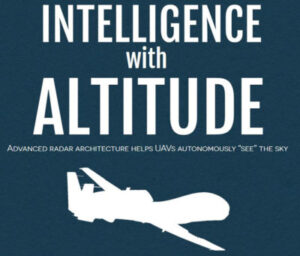
Colorado Engineering’s Advanced Radar Architecture Improves Defense Programs
Colorado Engineering Inc. (CEI) has experienced many successes since its inception in 2003, including its heavy involvement in the Department of Defense’s (DoD) Small Business Innovation Research (SBIR) program. The SBIR program is highly competitive and encourages domestic small businesses to engage in Federal Research/Research and Development (R/R&D) that has the potential for commercialization. The program also enables small businesses to explore their technological potential and provides the incentive to profit from its commercialization. CEI was recognized for its outstanding SBIR efforts in 2011 with the Tibbetts Award. This prestigious acclaim recognizes companies, organizations, and individuals that exemplify the very best in SBIR achievements.
Colorado Engineering’s SBIR successes have led to expanded opportunity for the company as well as increased effectiveness and cost efficiency for defense programs. “We have made the SBIR program a cornerstone of our business development,” said Colorado Engineering CEO Nancy Scally. “Before participating in the SBIR program, we had started with just two people. Today, thanks to projects like Radar Advanced Receiver/Exciter (RARE) and our many SBIR successes, we’ve expanded our staff and have seen revenues grow year after year.”
Under the SBIR program, CEI developed a ground-breaking, computing architecture that enabled the creation of a sense-and-avoid (SAA) radar design capable of fitting on an unmanned aerial vehicle (UAV ). This technology breakthrough became a solution for a variety of military and commercial radar applications, and the backbone for an extensive CEI product line. Learn more about CEI’s involvement in the SBIR program.
RARE architecture provides a modular hardware solution that can be more precisely scaled by stacking or tiling together individual computing sub-components and arranging them like building blocks without the need for a back plane. Sub-component combinations can be customized to meet specific computing requirements. Additionally, the design allows for the overall end-state functionality to be defined (and changed) through software changes in the architecture. This flexibility meets the needs for data processing speed as well as size, weight, and power constraints in radar system designs for UAVs.
Development of the RARE architecture first started under a 2006 SBIR contract from the Missile Defense Agency (MDA) seeking more affordable and flexible systems for ground-based radar for ballistic missile defense. CEI completed development of the foundational technology under a 2010 U.S. Air Force SBIR contract focused on development of an on board SAA sensor suite, including an air-to-air radar. The technology has since been explored for a variety of military and civilian applications.The U. S. Air Force and U. S. Navy have both pursued the RARE architecture as the core technology for an all-weather autonomous radar SAA capability to the U.S. Air Force Global Hawk and U.S. Navy Triton long-range surveillance UAVs. There is also interest in the technology from the U.S. Customs and Border Protection under the Department of Homeland Security.
MDA is a research, development, and acquisition agency within the Department of Defense. Its workforce includes government civilians, military service members, and contractor personnel in multiple locations across the United States. It is focused on retaining and recruiting a dedicated workforce interested in supporting U.S. national security.
CEI is a small, woman-owned business headquartered in Colorado Springs. It is one of the world’s foremost leading radio frequency (RF) and high-performance computing (HPC) solutions providers offering bleeding-edge technology solutions for the commercial, industrial, automotive, and military industries. CEI supplies off-the-shelf solutions for hardware and software as well as custom-tailored solutions for any application. CEI offers quick turn, innovative solutions, allowing for lower costs, and high-quality designs.
